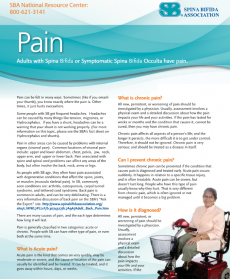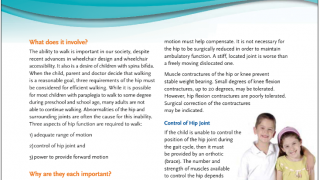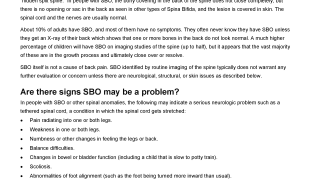Pain can be felt in many ways. Sometimes (like if you smash your thumb), you know exactly where the pain is. Other times, it just hurts everywhere.
Some people with SB get frequent headaches. Headaches can be caused by many things like tension, migraines, or Hydrocephalus. If you have a shunt, headaches can be a warning that your shunt is not working properly. (For more information on this topic, please see the SBA’s fact sheet on Hydrocephalus and shunts).
Pain in other areas can be caused by problems with internal organs (visceral pain). Common locations of visceral pain include upper and lower abdomen, chest, pelvis, jaw, neck, upper arm, and upper or lower back. Pain associated with spine and spinal cord problems can affect any areas of the body but often involve the back, neck, arms or legs.
As people with SB age, they often have pain associated with degenerative conditions that affect the spine, joints, or muscles (musculo skeletal pain). In SB, commonly seen conditions are: arthritis, osteoporosis, carpal tunnel syndrome, and tethered cord syndrome. Back pain is common in adults, and can be very debilitating. There is a very informative discussion of back pain on the SBA’s “Ask the Expert” site. http://www.spinabidaassociation.org/site/c.liKWL7PLLrF/b.3074327/k.7A9A/Adult_Back_Pain.htm
There are many causes of pain, and each type determines how long it will last. Pain is generally classified in two categories: acute or
chronic. People with SB can have either type of pain, or even both at the same time.
What is chronic pain?
All new, persistent, or worsening of pain should be investigated by a physician. Usually, assessment involves a physical exam and a detailed discussion about how the pain impacts your life and your activities. If the pain has lasted for weeks or months and the condition that causes it, cannot be cured, then you may have chronic pain.
Chronic pain affects all aspects of a person’s life; and the longer it persists, the more difficult it is to get under control. Therefore, it should not be ignored. Chronic pain is very serious, and should be treated as a disease in itself.
Can I prevent chronic pain?
Sometimes chronic pain can be prevented if the condition that causes pain is diagnosed and treated early. Acute pain occurs
suddenly. It happens in relation to a specific tissue injury, and is often treatable. Acute pain can be severe, but doesn’t last long. People who have this type of pain usually know why they hurt. That is very different from chronic pain, which is often ignored or not
managed until it becomes a big problem.
How is it diagnosed?
All new, persistent, or worsening of pain should be investigated by a physician. Usually, assessment involves a physical exam and a detailed discussion about how the pain impacts your life and your activities. If the pain has lasted for weeks or months and the condition that causes it, cannot be cured, then you may have chronic pain.
Chronic pain affects all aspects of a person’s life. This is because the brain and the body are inseparable, so both are affected by pain, as well as the conditions that cause it. People who suffer from chronic pain often have fatigue and difficulty to move around. Sometimes they are forgetful, have difficulty thinking clearly because they are distracted; or become pre-occupied by their discomfort, and it challenging to focus on tasks at work or school. Many people with chronic pain nd it difcult to exercise, eat properly, or sleep- that increases their risk for other health problems.
Chronic pain causes other conditions that make it difficult to cope- like anxiety and depression. Similarly, high stress or feelings of hopelessness increase levels of pain. So, it becomes a cycle that is difficult to break. This is why it is very important to treat the pain at 2 levels, the physical and the emotional level- and a team approach is the best way to do that.
Who should be on that team?
That depends on each person, The primary care doctor or physiatrist will help you determine which specialists you need. In general, the doctor who deals with the condition that is causing your pain, a psychologist, a pain medicine doctor, and a physical therapist or occupational therapist are important people to include in your care. If your pain affects your ability to work, then you might also need a vocational specialist.
How do you treat chronic pain?
Long-term pain medications If you choose to treat your pain with medications, you may need to take more than one medication. They can be in the form of pills, injections, creams, gels, or patches. Medications can be helpful in treating the pain but have unwanted side effects, like nausea, sleepiness, and dry mouth or constipation. Some people need their dosage of medication increased or changed because they build up a tolerance to the drug, so they require higher doses to get the same relief as they once did on a smaller dose.
Pain management programs are normally at “out-patient” hospital or clinic settings. Pain management programs are designed to help people who suffer from chronic pain. Pain management programs offer a variety of supports that treat the body and the emotions, like physical therapy, occupational therapy, water therapy, physician care, psychology/counseling, relaxation, and bio-feedback. If a pain management program is not right for you, your doctor might suggest only one or two of these therapies.
Psychotherapy, often in the form of Cognitive Behavioral Therapy (CBT) is often helpful when treatments have not been
successful. It is also helpful to receive CBT while undergoing other treatments. Counseling and CBT can help identify ways of coping with pain and its associated problems.
Intrathecal analgesia, or delivery of medication through a “pain pump” is often used for long-term chronic pain, which cannot be managed through more conservative means. With intrathecal analgesia, pain medications and sometimes muscle relaxers can be given through a pump that is surgically implanted in the abdomen. The pump delivers medication directly into the spinal cord through a
catheter. For some people, this method of pain management is successful for neck or back pain; and is advantageous because much smaller doses of medication can be used more effectively. However, it is not without risks, and your pain management doctor would be helpful in deciding if it is the right approach to manage your pain when other treatments have not been successful.
Alternative Therapies Alternative therapies can provide temporary relief from pain, and can be used with other pain management plans:
Massage Therapy
Water (hydro) Therapy
Acupuncture
Meditation or Feldenkreis
Music Therapy
Pet Therapy
Surgery is sometimes an option.
Support groups can be sources of information, understanding, and encouragement.
This information does not constitute medical advice for any individual. As specific cases may vary from the general information presented here, SBA advises readers to consult a qualified medical or other professionals on an individual basis.
Tags


